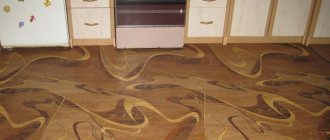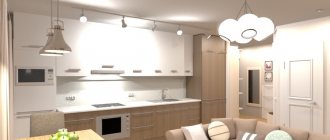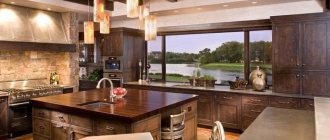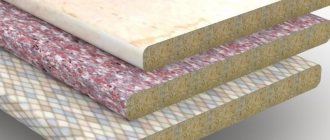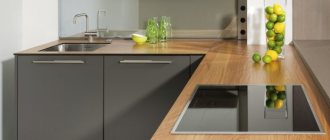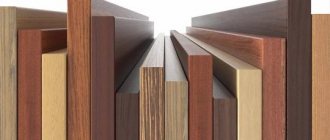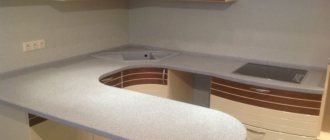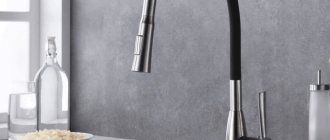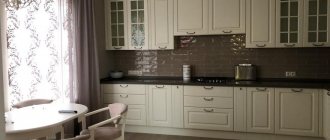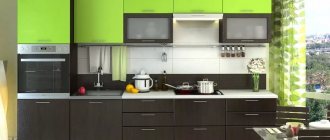What flooring to choose for the kitchen - this question arises for all homeowners who decide to carry out renovation work in this room. It must be said that the task of choosing is by no means an easy one, since today the assortment of construction stores offers such an abundance of different materials that, without information about them, you can easily get lost. Therefore, it makes sense to further consider the most popular floor coverings for the kitchen and take a closer look at their characteristics.
Flooring for the kitchen what to choose
Well, first you need to decide on the requirements that the floor covering in the kitchen must meet.
Tile
The most popular and sought after option is floor tiles. Its main advantages: low cost and ease of installation. The tiles are not afraid of water. And its huge selection - in colors, patterns and sizes - will allow you to create an original kitchen interior. You can combine tiles of different tones of the same color to create an interesting visual effect.
1/2
2/2
Coliseumgres Siena Bianco and Siena Grigio tiles
But the tiles have good heat transfer, so to make it comfortable to cook and walk barefoot in the kitchen, they install a heated floor.
Photo:
Senegal sand porcelain tiles
RUB 919.2*
Buy
*Price may change
Most popular options
When people talk about kitchen flooring, the first two materials that come up are ceramic tiles and linoleum. They are chosen in most cases. Although these materials are popular, they are not without their drawbacks.
Don't know what floors are best for your kitchen? Let's find out...
Kitchen floor tiles
In terms of practicality, ceramic floor tiles for wet areas are the best choice. It does not absorb any substances. Water, oil, or any other liquid will remain on the surface until you remove it. Where the liquid can be absorbed is into the seams. To prevent this from happening, choose moisture-resistant grout and fill the joints well. In terms of practicality and ease of maintenance, this kitchen flooring is among the first.
The advantages of this type of material also include a huge range. You can find any size, shape, color, with or without patterns. The choice is really large.
These were the advantages. Now about the cons:
- The tiled kitchen flooring feels “cold”. To make your feet comfortable, you can lay an electric heated floor under it (and you can also install water heated floors in the house).
- If you drop breakable dishes, they will break in 100% of cases. Moreover, the fragments scatter in different directions and then take a long time to collect them.
- Falling on tiles is very painful.
- Some species are very slippery even when dry. Those with a rough, embossed surface are much better in this regard - you won’t slip on them. But dirt gets clogged into the “relief” and you have to wash it out with a stiff brush, making considerable effort.
Kitchen flooring tiles can be matte or glossy - After some time - 3-5 years - abrasions begin to appear in places of active movement (stove-table-refrigerator). At first almost invisible, then more and more visible. Moreover, on expensive collections these abrasions also appear, maybe a little later. There are, of course, non-slippery and non-rubbing options, but they don’t look inspiring.
- The high cost of laying floor tiles. On average - $15 per square.
As you can see, there are also plenty of disadvantages. There is another consideration - on what base the tiles will be laid. If the floor is concrete, everything is simple. If necessary, it is leveled with a rough screed and then the tiles can be laid. If the floor is wooden, it is best to disassemble it and make a screed according to all the rules, and therefore lay the tiles on the finished floor. As a result, the total cost of floor repairs will be considerable.
Linoleum in the kitchen
The second most popular kitchen flooring is linoleum. As usual, let's start with the positives. If you take a whole piece of linoleum, then in terms of resistance to water this type of coating will not be inferior to ceramic tiles. Moreover, installation will take only a few hours, not days. You can lay linoleum on the floor yourself, but even if you have to hire a professional, this type of work is estimated at an average of $4-5 per square meter.
White linoleum in the kitchen with imitation wood flooring
If we talk about the range, it is no less than that of ceramic tiles. There are different options - from smoothly painted, to imitation wooden flooring, laminate or parquet, the same tiles, mosaics, etc. True, in order for linoleum in the kitchen to serve for a long time, you need to take a commercial or semi-commercial class, without a backing. It is more durable and has a hard top layer. In a house or apartment, it is almost eternal. But such material costs a lot: $25-35 per square meter is a completely normal price. So the price is about the same as laying tiles.
The advantages of linoleum in the kitchen also include a more comfortable atmosphere, as well as the fact that it is not so hard and, if dropped, some things have a chance to “survive”. Cleaning is no worse than tiles, even easier - streaks are usually not visible. In general, a good option.
Let's move on to the cons:
- You will have to pay a lot of money for a wear-resistant coating.
- The material is not environmentally friendly, although there is natural linoleum - marmoleum. The price is not lower than the commercial one, but the service life is much shorter.
Linoleum in the form of tiles - why not))
There seem to be few disadvantages, but they are significant. You also need to remember that linoleum must be laid on a flat base. It doesn't matter which one. The main thing is even, whole, clean. If the floor is concrete, you can go on it, but, again, it must be level. It is possible on a wooden floor, but if the boards are uneven, it is better to lay suitable sheet material on them - plywood, fiberboard, OSB, GVL. Choose for yourself. Linoleum is placed on top of a flat base, often gluing it over the entire surface. This kitchen flooring will be warm and durable.
Porcelain tiles
Porcelain tile has similar qualities to tile, but is much stronger and more likely to withstand the fall of a heavy object. In terms of decorativeness, like tiles, the coating offers many design options: the surface of porcelain stoneware can imitate wood, concrete, metal and other materials. An excellent solution is to use patterned and regular porcelain tiles at the same time.
If you find it difficult to choose between tiles and porcelain stoneware, choose the material that you like best in appearance - at home, they will cope equally well with their tasks.
Photo:
Rovigo edged 50.2*50.2 ceramic decor
RUB 716.4*
Buy
*Price may change
Natural wood
Wooden flooring made from natural species is a very environmentally friendly, but at the same time expensive option. However, it is precisely this kind of floor that can create a rich and respectable room design: it goes well with wooden furniture, looks noble and at the same time stylish. But when used in the kitchen, it must be protected from moisture, because water has a detrimental effect on wood. To create an original interior, you can lay not straight, but wavy boards.
This floor design is quite suitable for chalet, Scandinavian, loft and even minimalist style interiors, since the floor itself serves as the decor of the room.
Photo:
Solid board Stenwood Oak rustic 400-2000×100
RUB 2,280*
Buy
*Price may change
Criteria for choosing flooring for the kitchen
In this room the temperature constantly fluctuates and culinary passions burn: after all, the food will not cook itself. Hence the loads that any material used in it must withstand.
The optimal flooring material for a kitchen will be one that has most of the following characteristics:
- low hygroscopicity - the floor material should not absorb moisture to avoid mold;
- anti-slip coefficient - the higher the better, because sometimes in the kitchen you have to deftly dodge from the stove to the refrigerator or dining table, and injuries are definitely not needed here;
- hygiene and environmental friendliness - where food is located, there is no place for harmful fumes, accumulation of dirt and soot;
- resistance to mechanical damage - it’s not always possible to hold everything in your hands, so the floor must more or less cope with dropped dishes;
- good thermal insulation or heat conduction properties - even in winter it should be comfortable to cook food or just drink coffee in the morning.
Designer refinements in floor design have also not been canceled: the most universal solutions are welcome, which can easily be adapted to modern interiors and create a cozy and homely atmosphere in the kitchen.
Parquet
Parquet is lighter than solid boards, since natural wood is only in the top outer layer. The rest of the structure consists of cross bars with grooves for easy and quick connection. In addition, the parquet initially has a protective varnish coating, which allows it to be used in the kitchen.
1/2
2/2
Bauwerk Black Limited parquet and Smoked Oak
If it is possible to use parquet in the interior, this is certainly the best option, since the joints of two materials, such as laminate and tiles, always create some visual tension.
Photo:
Verona Oak
RUB 3,550*
Buy
*Price may change
About screed and insulation
When renovations are in full swing, the question of which coatings to choose is not the most pressing. Now the main thing is screeding and leveling the surface.
Before choosing the material from which the screed will be made, you need to think about what you will lay on top.
If it’s a tile, then it makes no difference what’s underneath and regular cement mortar will do. And if it is a laminate, then it is much better to make a gypsum screed using a plaster mixture. This floor will be much warmer and less moisture permeable.
Also, the thickness of the screed may depend on what type of insulation you choose.
And if you raised the screed high enough, then making wooden flooring is no longer very reasonable if your ceiling height is standard, that is, 2.5 meters. If you “steal” an extra 10 cm, this will significantly affect the visual perception of the room.
And if you are also planning a suspended ceiling, then this will not be good at all. Now let's get closer to the topic and talk about specific coatings.
Laminate
A more economical option compared to natural wood is laminate. It is less environmentally friendly, but it is scratch resistant and easier to install. But the kitchen coating requires moisture-resistant treatment. The material imitates any wood surface, so its aesthetic qualities are not much inferior to wood.
Still, it should only be used in the kitchen if you cook infrequently or very carefully so that splashes of moisture and grease do not fall on the floor.
Photo: i0.wp.com
LAMINATE EUROHOME ART 12/33 4V OAK EGGSHELL GT 1.48 M2
750 rub.*
Buy
*Price may change
No. 9. A natural stone
Natural stone on the floor is a sign of luxury and chic. Such kitchens look very impressive , but such finishing will cost you quite a lot. Natural stone is very durable, it is difficult to damage , and in terms of durability it is confidently ahead of almost all alternative types of finishing.
But natural stone also has significant disadvantages. This is a cold coating that does not retain heat well, so those who appreciate maximum comfort will not be able to do without installing a heated floor system. Caring for natural stone is quite complicated , but the installation process is also not easy. In addition, the stone has a decent weight , so reinforcement of the floors may be necessary.
Cork
A natural material that will decorate any interior thanks to the abundance of colors and textures. Cheaper than natural wood, but with similar decorative qualities and environmental friendliness. For a kitchen, a cork floor coated with varnish would be an excellent solution, as it is easy to clean and is not afraid of stains. It will look most organic with wooden furniture, but cork can also be used in other styles, creating an unusual design.
In addition, cork is an excellent soundproofing material, which is important in modern new buildings.
Photo: thisoldhouse.com
Cork floor CorkArt Natural
RUB 2,240*
Buy
*Price may change
Linoleum
Synthetic linoleum is an excellent option for the kitchen. It's cheap and very easy to install with your own hands. The material is wear-resistant, so it will last a long time. Modern linoleum with many different patterns - wood, tile or even abstract - will allow you to choose the coating to suit any interior style.
Today, linoleum is again gaining popularity: it has become more environmentally friendly; it is often chosen by those who have lost their favorite cup that fell on a hard tile surface. In addition, it does not require underfloor heating.
Photo:
Linoleum "Palermo" 32 class, 3 m
RUB 478*
Buy
*Price may change
Warm floor in the kitchen
Heated floors in the kitchen will allow you to comfortably walk around this room even in the cold season. This is especially true if you have ceramic tiles laid, the apartment is located on the first floor exactly above the basement, or the heating system operates at an average level. They install both electric and water heated floors.
Electric heated floors can be:
- cable - based on a two-core shielded cable, poured into a cement screed, ideal for tiles;
- film - based on a carbon film with copper and carbon fiber, very economical and loses less heat, optimal for installation under linoleum, laminate and parquet, and does not require screed;
- rod - infrared, is a mesh with intersecting carbon and copper elements, tile-like, universal and durable.
The installation of floor heating systems should be trusted to specialists in order to avoid subsequent operational issues. Be prepared to pay many times more for electricity. But this is quite a worthy exchange for comfort, isn’t it?
In private homes, water-heated floors are often used, which are cheaper in cost. It works by circulating water in a structure, the key elements of which are a collector and a thermostat. The base also needs to be well prepared: leveled, insulated, and provided with a vapor barrier. Only then can you begin installing the heating elements - in increments of 25-30 cm. After all the pipes have been laid, all that remains is to connect them to a common manifold. Using a thermostat, you can set the desired temperature - and in this simple way achieve the optimal level of heat all year round.
Terrazzo
A seamless mosaic (terrazzo) coating in the kitchen will help create an individual interior. This pattern of individual elements will become an original decoration of the room and will suit any style, depending on the color and texture. An interesting option is to use not a classic mosaic made of glass or ceramics, but to create, for example, a covering made of marble or stone.
An excellent solution for a country house, the size of the kitchen-living room allows you to enjoy the pattern of the stone and walk on it without taking off your summer shoes.
Photo: diespeker.co.uk
Terrazzo gray mosaic 14.7*14.7 ceramic decor
RUB 373.2*
Buy
*Price may change
The most beautiful kitchen floors in photos
An interesting selection of spectacular floors, which we have divided into two parts. Whoever has a kitchen will be more interested in this scale.
